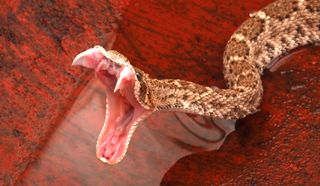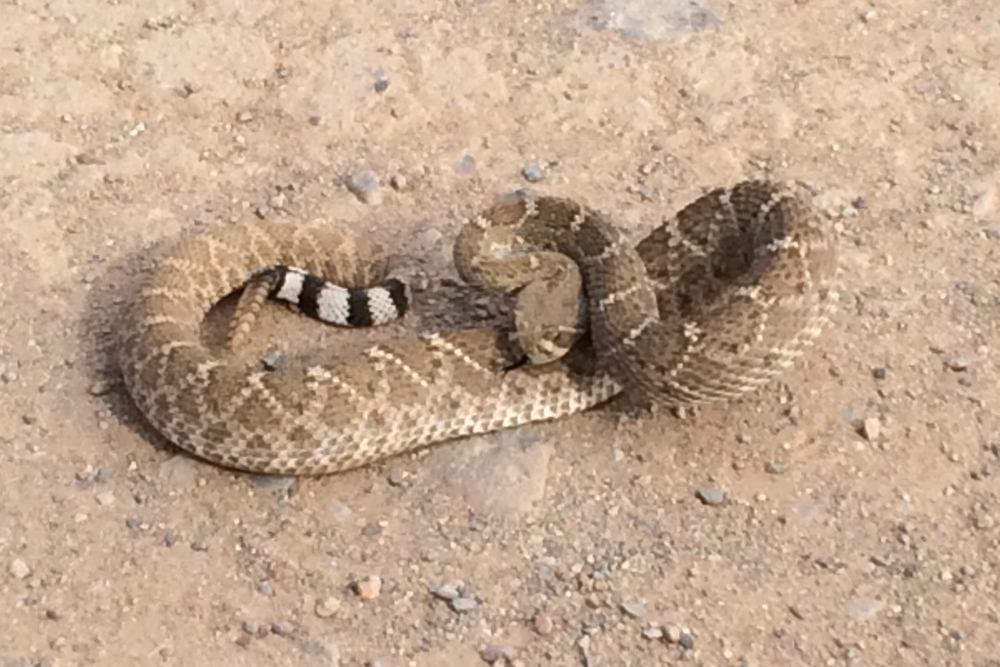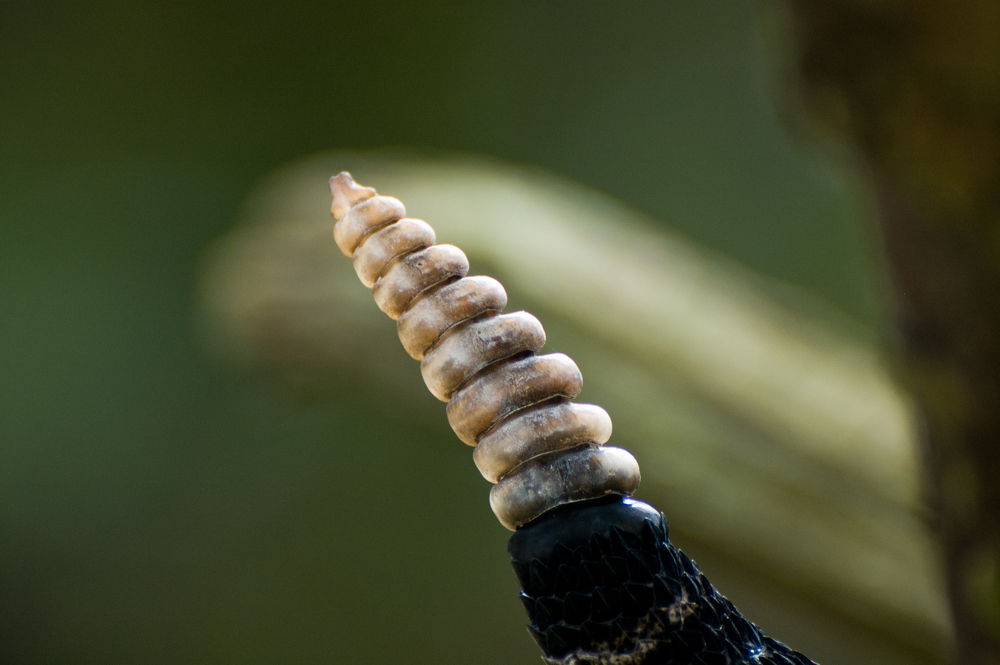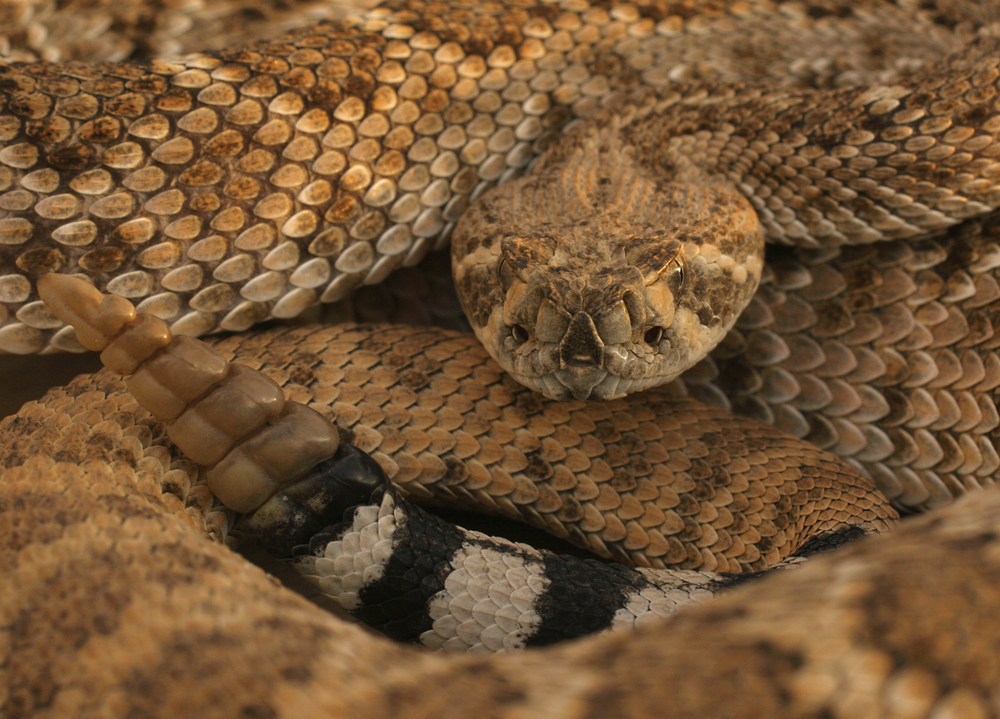How Many Babies Does a Rattlesnake Usually Have
Rattlesnake Facts

Rattlesnakes are large, venomous snakes that are found throughout N and South America. The greatest concentration of them is in the Southwestern United States and in Northern Mexico. Arizona is home to 13 species of rattler, more than than any other state. The most distinctive feature that these species share is the rattle.
Rattle and hiss
Residents of the Southwestern United States likely take heard the distinctive buzz of these pit vipers. Their namesake rattle is a highly effective warning sign, signaling predators to stay abroad. "Rattles are segments of keratin that fit loosely inside ane some other at the finish of the snake's tail," explained Sara Viernum, a herpetologist based in Madison, Wisconsin. "These segments knock confronting each other to produce a buzzing sound when the snake holds its tail vertically and vibrates the rattle. Each time a rattlesnake sheds its peel it adds another segment to the rattle."
Scientists consider the rattlesnake'southward rattle a highly evolved and sophisticated warning system — which makes sense since, according to the San Diego Zoo, these are the newest and virtually evolved snakes in the world.
Rattlesnakes also hiss, a 2d element of its warning posture that is oft overlooked and overshadowed by its rattle, writes Laurence Monroe Klauber in "Rattlesnakes: Their Habits, Life Histories, and Influence on Mankind" (University of California Press, 1997). Viernum said the behavior "is like to a cat hissing when threatened past a canis familiaris. In rattlesnakes, hissing and rattling their tails both serve equally warning signals.
"The process of hissing occurs when a snake forcefully expels air from the glottis inside the throat," Viernum continued. "This causes structures inside the glottis to rattle, creating the hissing sound." The snake's ane functional lung has relatively large air capacity, and as the ophidian hisses, its body may bang-up upwardly or deflate. Interestingly, snakes are deafened to airborne sounds, and then the hiss is but a alert for animals that can hear and not a means of advice with other snakes.

Characteristics
Rattlesnakes tin range from one to eight anxiety, depending on the species (the big i is the eastern diamondback), according to the National Wildlife Federation. They are thick-bodied snakes with keeled (ridged) scales in a variety of colors and patterns. Most species are patterned with dark diamonds, rhombuses or hexagons on a lighter background.
"Other distinctive concrete characteristics include producing venom, heat-sensing facial pits, hinged fangs and live births," said Viernum. "These characteristics are shared with other pit vipers such equally the cottonmouthand copperhead." After the rattle, rattlesnakes' most distinctive physical characteristic is their triangular head. Also, they accept vertical pupils, like cat'southward eyes.
Immature rattlesnakes practice not yet accept their rattles, though they are equally dangerous equally adults, according to the National Park Service at Yosemite. Furthermore, some adults may lose their rattles, so information technology is a good idea look out for the triangular caput.
Habitat
These adjustable serpents can thrive in a variety of environments. They are most abundant in the desert sands of the Southwest, but they besides like grasslands, scrub brush and rocky hills. They can be found in the swamplands of the Southeastern The states and in the meadows of the Northeast. These snakes can handle high top and are institute everywhere from sea level to 11,000 anxiety (three,353 g), co-ordinate to the San Diego Zoo.

Habits
Rattlesnakes spend some time in dens, which they make in rocky crevices. Those in colder climates hibernate there for the wintertime. Co-ordinate to the South Dakota Game, Fish, and Parks Department, generation after generation of rattlesnake will use the same dens. The San Diego Zoo reported that they sometimes use the same den for more 100 years. Upon leaving their dens, they like to lord's day themselves on rocks and other open places. Though they are non nocturnal, in the hot summer months they may be more than active at night.
Despite their venom, rattlesnakes are no match for rex snakes, which are fond of putting them on their dinner menus, according to the California Section of Fish and Wild fauna.
In add-on to rattling and hissing, rattlesnakes exhibit other defensive behaviors. "They may besides curlicue their bodies and raise their heads high off the footing in a defensive posture," said Viernum. "This coiled position serves as a mode to ballast the torso if they torso if they feel the need to strike with their raised head.
Rattlesnakes are ovoviviparous, which ways that eggs incubate inside the mother's body. Babies are born live, encased in a thin membrane that they puncture after being born. Ratters mate in the spring and summer, depending on the species, and, according to the Denver Zoo, males may appoint in combat. Mothers can shop sperm for months earlier fertilizing the eggs, and then they carry babies for nigh three months. They only give nascence every two years, usually to about ten baby rattlers. Mothers don't spend any time with their offspring, slithering off every bit soon as they are built-in.
The National Wild animals Federation reported that rattlesnakes typically live for 10 to 25 years.
Diet
Rattlesnakes' favorite foods are small rodents and lizards. They lie in await until a victim comes along, and then strike at speeds of five-tenths of a second, co-ordinate to the San Diego Zoo. Their venom paralyzes the casualty, which they so eat whole. Co-ordinate to the University of Michigan Museum of Zoology'south Creature Diversity Web (ADW), timber rattlesnakes wait until the prey is expressionless earlier swallowing it. The digestive process can take several days, and rattlesnakes get sluggish and hide during this fourth dimension. Adult rattlers eat about every two weeks.
Bite
About people bitten past rattlesnakes have inadvertently stepped on them — and so watch where y'all're walking! Rattlesnake bites can be dangerous but are very rarely fatal to humans. With proper medical handling, including antivenin, bites are usually non serious.
Their venom is extremely potent. "The venom of almost rattlesnake species is composed mainly of hemotoxins," Viernum said. "Symptoms include temporary and/or permanent tissue and muscle damage, loss of an extremity depending on the location of the bite, internal bleeding, and farthermost pain around the injection area."
Some rattlesnake species take venom that contains neurotoxins. "Mojave, tiger, and speckled rattlesnakes are examples of rattlesnakes where either the entire species or certain populations within the species produce neurotoxins," said Viernum. She explained that neurotoxins human action faster than hemotoxins and assail the nervous organization. "Symptoms from a neurotoxic rattlesnake seize with teeth include problems with vision, difficulty swallowing and speaking, skeletal muscle weakness, difficulty breathing, and respiratory failure."
Nevertheless, Viernum reinforced the thought that fatalities from rattlesnake bites are rare if treated in a timely fashion.
Co-ordinate to DesertUSA, there is some testify that rattlesnake venom is becoming more neurotoxic across the board, which may be an evolutionary strategy, every bit some rodents are evolving to exist more resistant to hemotoxins.

Nomenclature/taxonomy
Rattlesnakes are pit vipers, in the same family unit (Viperidae) every bit cottonmouths, copperheads and other vipers. Rattlesnakes are in the genus Crotalus, and are closely related to pygmy rattlesnakes, which are in the genus Sistrurus.
The taxonomy of rattlesnakes, according to the Integrated Taxonomic Information System (ITIS), is:
- Kingdom: Animalia
- Subkingdom: Bilateria
- Infrakingdom: Deuterostomia
- Phylum: Chordata
- Subphylum: Vertebrata
- Infraphylum: Gnathostomata
- Superclass: Tetrapoda
- Form: Reptilia
- Social club: Squamata
- Suborder: Serpentes
- Infraorder: Alethinophidia
- Family: Viperidae
- Subfamily: Crotalinae
- Genus: Crotalus
Species
There are 29 species, including:
Timber rattlesnake (Crotalus horridus)
Sometimes called a canebrake rattlesnake, these snakes found in the Eastern United States. According to the New Hampshire Fish and Wildlife Department, they are large, regularly growing up to v anxiety (one.five thou) long, and have a large banded or chevron-shaped brown and black pattern. Nevertheless, information technology is hard to run into the brown pattern on some snakes, and they look uniformly blackness. On others, the groundwork is tan and their bands are clearly brownish. According to the Florida Museum of Natural History, timber rattlesnakes in the Sunshine State and other parts of the South are lighter colored with a cherry brown stripe running down the center of their backs.
Eastern diamondback (Crotalus adamanteus)
According to National Geographic, these are the largest venomous snakes in Northward America, reaching up to 8 feet (2.4 m). They are found from North Carolina to Louisiana. They have a visually hitting yellow-bordered black diamond pattern.
Western diamondback (Crotalus atrox)
At up to 7 feet long (2 m), this is the largest of the Southwestern rattlers and considered the near dangerous. According to the ADW, it causes more than fatalities than any other serpent in the Us. Its dorsum is covered with night diamond-shaped patches lined with lighter scales, and co-ordinate to the Arizona-Sonora Desert Museum, its rattle has a unique blackness-and-white, raccoon-like color scheme. Different many other rattlers who flee, the Western diamondback volition stand its ground, coil, and hiss when threatened.
Tiger rattlesnake (Crotalus tigris)
A small rattlesnake reaching less than three feet (1 m), this Southwestern rattlesnake has all-encompassing cantankerous-banding and the smallest head of whatsoever rattler, according to the ADW. Its bands may exist brownish or gray in color on a brownish or orangish-ish background. Its head is small in proportion to its body, then it holds less venom — though information technology is no less potent.
Conservation status
Most species of rattlesnakes are not endangered, according to the International Union for the Conservation of Nature (IUCN). Still, the group'south Cerise Listing of Threatened Species lists three species of business organisation:
The Santa Catalina Island rattlesnake (Crotalus catalinensis) is "critically endangered" because of its limited range (it is constitute merely on Santa Catalina Island off the coast of California), over-drove and killing past humans and feral cats.
The long-tailed rattlesnake (Crotalus stejnegeri) is listed as "vulnerable." This species lives in western United mexican states. It is a rare species, co-ordinate to the IUCN, and is known simply from a few specimens. The population is likely decreasing due to loss of habitat caused by logging and agriculture.
The Tancitaran dusky rattlesnake (Crotalus pusillus) is listed as "endangered" because it is found only in a small expanse of United mexican states; yet, no population information is available.
Additional resources
- San Diego Zoo: Fun Facts Nearly Rattlesnakes
- Sara Viernum and her team at "The Wandering Herpetologist," are dedicated to providing news, facts, and educational data about amphibians and reptiles.
- Animal Diversity Web: Timber rattlesnake
Source: https://www.livescience.com/43683-rattlesnake.html
0 Response to "How Many Babies Does a Rattlesnake Usually Have"
Postar um comentário